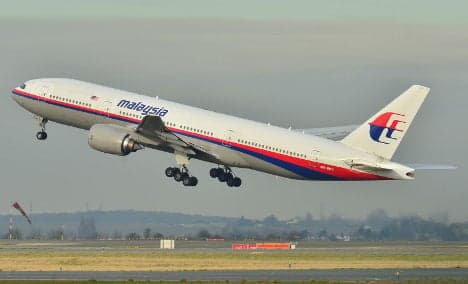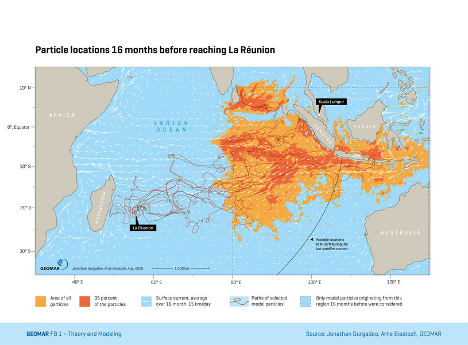Kiel scientists: MH370 search in wrong place

German scientists have challenged conventional wisdom on the crash site of the MH370, the Malaysia Airlines plane missing since March 2014, suggesting the search is being conducted in the wrong place.
The researchers from Kiel's Helmholtz Centre for Ocean Research presented the results of their computer simulations on Tuesday, showing that current searches for the plane are probably taking place too far to the south.
The simulations traced probable ocean currents which could have led a piece of the aircraft to wash up on the shores of La Reunion, a French island in the south-west of the Indian Ocean in July.
Scientists Arne Biastoch and Jonathan Durgadoo concluded that the search - currently placed 2,000 kilometres off the west coast of Australia - was way off the mark.
"Our results show that the current focus of the search for the aeroplane south-west of Australia could lie too far to the south," said Durgadoo.
Thousands of currents push objects in the ocean around like balls in a pinball machine, making it impossible to point to an exact place of origin for the piece of debris, Der Spiegel reported.

The researchers traced 2 million virtual pieces of debris from the shores of La Reunion backwards in time 16 months, according to possible routes that ocean currents could have dragged them in.
The result is a map which shows an enormous stretch of sea from which the debris could have floated.
But the scientists pointed out that on the basis of a single piece of debris, more accurate conclusions are not possible.
"Further pieces of debris would be necessary in order to make a more specific statement," said Biastoch.
The evidence which has led search teams to their current search site are seven 'pings' received by a British satellite which the plane sent out automatically every hour.
The last 'ping' was received on March 8th 2014 at 1:11 am. Experts were able to make conclusions as to the flight route of the plane based on the location of the satellite when it received the signal.
They then estimated the furthest distance the plane could have flown from this point and narrowed their search area down to a stretch of 120,000 square miles large and 2,000 kilometres west of Perth.
The find in La Reunion at first seemed to strengthen conclusions regarding the current search area, but the Kiel researchers' research has added yet another level of doubt as to what is already one of the most notorious mysteries in aviation history.
Flight MH370 disappeared in March of last year while flying from Kuala Lumpur, Malaysia over the South China Sea to Beijing. more than 200 people from 15 different countries were on board and its vanishing has led to a multinational search effort since.
Comments
See Also
The researchers from Kiel's Helmholtz Centre for Ocean Research presented the results of their computer simulations on Tuesday, showing that current searches for the plane are probably taking place too far to the south.
The simulations traced probable ocean currents which could have led a piece of the aircraft to wash up on the shores of La Reunion, a French island in the south-west of the Indian Ocean in July.
Scientists Arne Biastoch and Jonathan Durgadoo concluded that the search - currently placed 2,000 kilometres off the west coast of Australia - was way off the mark.
"Our results show that the current focus of the search for the aeroplane south-west of Australia could lie too far to the south," said Durgadoo.
Thousands of currents push objects in the ocean around like balls in a pinball machine, making it impossible to point to an exact place of origin for the piece of debris, Der Spiegel reported.

The researchers traced 2 million virtual pieces of debris from the shores of La Reunion backwards in time 16 months, according to possible routes that ocean currents could have dragged them in.
The result is a map which shows an enormous stretch of sea from which the debris could have floated.
But the scientists pointed out that on the basis of a single piece of debris, more accurate conclusions are not possible.
"Further pieces of debris would be necessary in order to make a more specific statement," said Biastoch.
The evidence which has led search teams to their current search site are seven 'pings' received by a British satellite which the plane sent out automatically every hour.
The last 'ping' was received on March 8th 2014 at 1:11 am. Experts were able to make conclusions as to the flight route of the plane based on the location of the satellite when it received the signal.
They then estimated the furthest distance the plane could have flown from this point and narrowed their search area down to a stretch of 120,000 square miles large and 2,000 kilometres west of Perth.
The find in La Reunion at first seemed to strengthen conclusions regarding the current search area, but the Kiel researchers' research has added yet another level of doubt as to what is already one of the most notorious mysteries in aviation history.
Flight MH370 disappeared in March of last year while flying from Kuala Lumpur, Malaysia over the South China Sea to Beijing. more than 200 people from 15 different countries were on board and its vanishing has led to a multinational search effort since.
Join the conversation in our comments section below. Share your own views and experience and if you have a question or suggestion for our journalists then email us at [email protected].
Please keep comments civil, constructive and on topic – and make sure to read our terms of use before getting involved.
Please log in here to leave a comment.